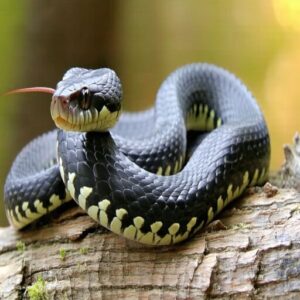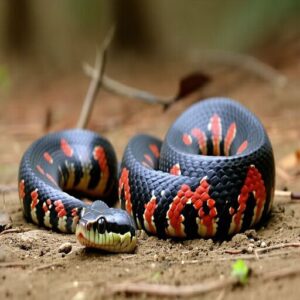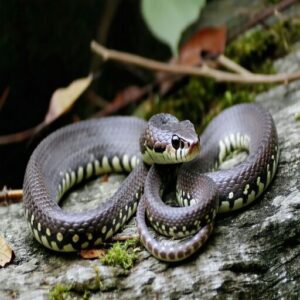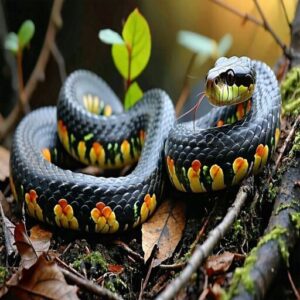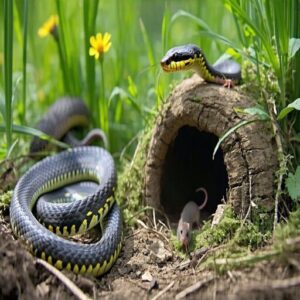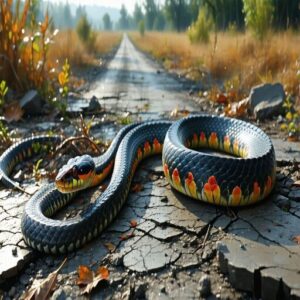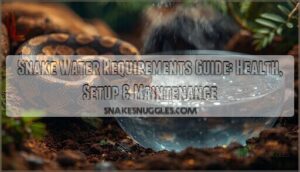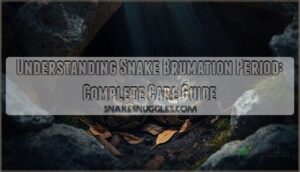This site is supported by our readers. We may earn a commission, at no cost to you, if you purchase through links.

Their bright red, black, and yellow bands may look intimidating—like a venomous coral snake—but it’s all for show. This clever mimicry helps scare off predators.
Milk snakes don’t use venom; instead, they constrict their prey, wrapping around it to hunt. You can tell them apart from venomous snakes by their round pupils and slender heads.
Plus, remember the rhyme: “Red on black, friend of Jack; red on yellow, kill a fellow.” These harmless snakes play an important role in controlling pest populations.
Curious? Let’s explore their world further!
Table Of Contents
- Milk Snake Identification
- Debunking The Poisonous Myth
- Ecological Role of Milk Snakes
- Milk Snake Behavior and Habitat
- Coexisting With Milk Snakes
- Dispelling Fear and Misconceptions
- Encouraging Conservation Efforts
- Safe Handling and Encounter Protocols
- Education and Community Outreach
- Are milk snakes venomous?
- Do milk snakes bite?
- Are milk snakes good pets?
- Do milk snakes eat coral snakes?
- Why are milk snakes killed?
- Is a milk snake poisonous to dogs?
- What happens if a milk snake bites you?
- What snake looks like a milk snake but is poisonous?
- How do you tell the difference between a copperhead and a milk snake?
- Are milk snakes friendly?
- Conclusion
Milk Snake Identification
You’ll spot a milk snake by its smooth, shiny scales and distinctive bands of red, black, and white or yellow colors that mimic more dangerous species.
Smooth, shiny scales and bold red, black, and white bands make milk snakes nature’s ultimate bluff artists.
Despite looking like their venomous cousins, these harmless reptiles have round pupils and unique spot patterns on their backs that set them apart from truly dangerous snakes.
Physical Characteristics of Milk Snakes
Milk snakes are sleek, medium-sized constrictors that typically measure between 2-4 feet in length.
You’ll notice their cylinder-shaped bodies with glossy, smooth-as-silk scales that feel almost velvety to touch. These distinctive reptiles feature petite heads and pointed snouts that help distinguish them from other snake species.
Here are 3 key milk snake characteristics to identify them:
- Scale Texture: Their scales are remarkably smooth and shiny, lacking the rough keels found on many venomous species.
- Body Shape: Their slender, uniform width bodies maintain a consistent cylindrical form from head to tail.
- Head Structure: Milk snakes have small, rounded heads that blend almost seamlessly with their necks, unlike venomous milk snake lookalikes.
Color Patterns and Mimicry
The dazzling bands on milk snakes aren’t just for show—they’re a masterful example of Batesian mimicry that helps these harmless reptiles survive.
Milk snakes use their striking bands as nature’s decoy, mimicking venomous cousins to fool predators and stay safe.
- Color patterns vary regionally, from vibrant reds and blacks to more subdued tones, enhancing their snake camouflage abilities.
- Their distinctive banding mimics venomous coral snakes, sending powerful visual signals to would-be predators.
- This defensive strategy works like a natural "beware" sign, despite milk snakes having no venom.
- Pattern variation exists among subspecies, with some sporting bright, bold bands while others display more subtle color mimicry.
Nature’s ultimate bluff artist, milk snakes use their looks as protection rather than actual weapons.
Distinction From Venomous Snakes
Despite their alarming colors, telling milk snakes from venomous species is easier than you think.
Look for rounded pupils and heads in milk snakes, not the elliptical pupils and triangle-shaped heads of venomous snakes.
Snake mimicry is their clever defensive strategy – milk snakes aren’t poisonous at all, they use constrictor methods to catch prey, not venom or poison.
Remember the rhyme: "Red on black, friend of Jack; red on yellow, kill a fellow" to identify these non-venomous snakes safely.
Understanding venomous snake characteristics is essential for accurate identification and safety precautions.
Geographic Distribution and Habitat
From Canada to Venezuela, milk snakes enjoy a vast geographic range across North and Central America.
You’ll find these adaptable reptiles thriving in diverse milk snake habitats:
- Dense forest ecosystems where they hide under fallen logs
- Rocky terrain with plenty of crevices for shelter
- Agricultural areas and barns where rodent prey is plentiful
- Woodland edges that provide both cover and hunting grounds
Eastern milk snake populations are especially common throughout the eastern United States, though habitat loss increasingly threatens these beneficial creatures in some regions, affecting their ability to survive in their natural diverse habitats.
Debunking The Poisonous Myth
You’ll be relieved to know that milk snakes are completely non-venomous and pose absolutely no poisonous threat to humans, despite their striking resemblance to some dangerous species.
Milk snakes are harmless, non-venomous wonders with striking colors, often mistaken for dangerous species—but they’re nature’s ultimate bluff artists.
Their vibrant banded patterns might fool predators into thinking they’re venomous, but these harmless reptiles are actually helpful creatures that use constriction to capture their prey.
Origins of The Misconception
The colorful appearance of milk snakes has fueled widespread misconceptions about their nature.
While their vibrant bands might suggest danger, these misconceptions stem from confusion, not facts.
You’ve probably heard someone ask, "Is the milk snake poisonous?" This confusion often comes from their resemblance to venomous coral snakes.
These Mythical Beliefs about milk snake venom or milk snake poison persist despite evidence that milk snakes are completely harmless constrictors.
Understanding the concept of snake venom immunity is essential in debunking the myth that milk snakes are poisonous.
Lack of Venom in Milk Snakes
Many people wonder if milk snakes are dangerous when they encounter these colorful reptiles.
The truth is simple: milk snakes have zero venom mechanism in their bodies.
You’ll never find venom glands or delivery fangs in these harmless species.
Unlike their venomous lookalikes, milk snakes can’t inject toxins when they bite.
Their defense relies purely on bluffing through mimicry.
The milk snake’s vibrant bands mimic venomous species, but it’s just nature’s clever trick.
When a milk snake opens its mouth, you’ll see only tiny teeth meant for gripping prey, not delivering poison.
Snake safety experts confirm that milk snakes are completely non-venomous snakes.
You can breathe easy knowing these beautiful creatures pose no toxic threat to humans.
Constriction as a Hunting Method
Milk snakes hunt with impressive precision, not poison.
These non-venomous snakes rely on constriction techniques to capture prey.
When hunting, they patiently wait for the right moment, then strike quickly, wrapping their muscular bodies around victims.
This tight squeeze cuts off blood flow and oxygen, causing suffocation, making them efficient predators without a drop of venom.
Their camouflage helps them remain hidden until it’s time to ambush.
Non-Venomous Snake Behavior
Despite their vibrant warning colors, milk snakes display typical non-venomous snake behavior when encountering humans.
They’ll rely on defensive displays like tail-shaking to mimic rattlesnakes before attempting escape. Unlike venomous species, these harmless reptiles prefer flight over fight, often freezing or slithering away quietly.
Their movement patterns revolve around habitat selection and prey acquisition, not confrontation. Rest assured, milk snakes aren’t dangerous—they’re simply masters of bluffing and their behavior is centered on non-venomous characteristics.
Ecological Role of Milk Snakes
You’ll find these colorful reptiles working hard as nature’s pest controllers, keeping rodent populations in check while maintaining the balance of local ecosystems.
As they hunt mice, rats, and other small mammals in forests and agricultural areas, milk snakes contribute substantially to biodiversity despite facing threats from habitat loss and human misidentification.
Pest Control and Rodent Population Management
From myths about poison to heroes of the harvest, milk snakes deserve recognition for their remarkable pest management skills.
These non-venomous snakes provide exceptional rodent control services throughout farms and homes.
- A single milk snake can devour up to 20 rodents monthly during peak seasons
- Farmers report 25-35% less grain loss when milk snakes are present
- They save property owners up to $1,000 annually in pest control costs
- Their slim bodies access rodent nests in tiny crevices other predators can’t reach
Effective rodent control methods are essential for maintaining ecological balance.
Impact on Local Ecosystems
While rodents may be their main meal, milk snakes create ripple effects throughout their habitats.
Their species interactions touch every corner of the ecosystem balance.
Here’s how these colorful reptiles impact their surroundings:
- Regulate small mammal populations beyond just rodents
- Break down nutrients through waste production
- Support larger predators as occasional prey
- Maintain genetic diversity through mating behaviors
- Prevent disease spread by consuming sick animals
Your local eastern milk snake isn’t just pretty—it’s a silent environmental guardian that plays a crucial role in its ecosystem.
Biodiversity and Conservation Efforts
Beyond controlling pests, milk snakes play a vital role in preserving biodiversity.
Their conservation status requires our attention. Understanding milk snake characteristics is essential for effective conservation efforts.
You’ll find these non-poisonous reptiles serve as indicators of healthy ecosystems. By protecting milk snakes, you’re safeguarding entire food webs and ensuring nature’s delicate balance continues for generations to come, which is crucial for ecosystem balance and wildlife management.
Threats to Milk Snake Populations
Milk snakes face several threats endangering their survival.
Habitat loss leads the list, as urbanization destroys the forests and fields they call home.
Road mortality adds to their plight when milk snakes cross roads searching for food or mates.
Pesticide use harms their prey and poisons their environment, while the exotic pet trade depletes wild populations.
Tackling these issues through snake conservation efforts is essential for preserving milk snake species and maintaining ecosystem balance.
Milk Snake Behavior and Habitat
You’ll find milk snakes in forests, fields, and even barns, where they stay hidden under rocks or in dark spaces.
They’re solitary, active mostly at night, and rely on their quick reflexes and strong constriction to catch prey.
Hunting and Feeding Habits
A milk snake’s hunting strategies are fascinating.
These nocturnal hunters rely on their sense of smell to track a wide prey variety, from rodents and reptiles to birds and insects.
Their constriction method effectively suffocates prey, which they swallow whole using flexible jaws.
Feeding frequency depends on size and age—young milk snakes stick to insects, while adults prefer small mammals.
This milk snake behavior helps keep ecosystems balanced and highlights fascinating milk snake facts in the wild, showcasing their importance with effective hunting strategies.
Shelter and Hibernation Patterns
When temperatures drop, milk snakes turn into masters of snug living. They pick perfect denning sites like rock crevices, hollow logs, or winter burrows abandoned by other animals.
Snake hibernation isn’t solitary—these serpents often share their cozy spots with others, forming a hibernation cycle that conserves heat. Their shelter selection showcases clever cold weather adaptations, keeping them safe and warm.
Whether hidden underground or tucked under debris, milk snake behavior highlights incredible shelter patterns that guarantee survival through frosty months in their unique habitat. To prepare for such periods, snake owners can utilize proper snake hibernation kits to replicate ideal conditions, ensuring a safe hibernation.
Reproduction and Mating Rituals
As spring rolls in, milk snakes are ready for action, kicking off their breeding seasons with fascinating courtship behavior.
Males compete fiercely to catch a female’s eye, often engaging in headbutting and tongue flicking as part of their courtship display. You could say it’s nature’s way of showing off their best moves!
Once a pair is formed, the female gets to work ensuring the next generation thrives. Here’s how milk snake reproduction unfolds:
- Mating Habits: Spring sparks activity, with males seeking receptive females.
- Courtship Behavior: Competitive displays like headbutts and subtle movements help males impress.
- Nesting Patterns: Females select hidden spots (rocks, logs) for egg laying.
- Egg Development: Eggs incubate for 6-9 weeks, protected by their chosen site.
- Hatchlings: Baby milk snakes emerge self-sufficient, measuring 10–12 inches.
Milk snakes amaze with their cycle of life! The complex snake mating rituals play a vital role in their reproductive success.
Social Structure and Interaction
Snakes don’t throw parties, but milk snakes have a social side when necessary.
Their solitary nature defines most of their lives, yet they share communal dens during chilly winters. Outside hibernation, interaction is rare, limited to mating rituals or chance encounters.
Here’s the scoop on their social structure:
- These snakes prefer solitude but tolerate neighbors in shared dens.
- Encounters are brief—mostly for mating or survival.
- Subtle movements and scent marking establish hierarchy and boundaries.
- Their nocturnal habits discourage much mingling.
Understanding milk snake behavior helps build trust and supports coexistence.
Coexisting With Milk Snakes
You don’t have to fear milk snakes—they’re harmless and even helpful to have around.
By learning to spot and respect these colorful reptiles, you can avoid misunderstandings and support their role in nature.
Dispelling Fear and Misconceptions
You’ve probably heard the wild tales—"Are milk snakes poisonous?" or "Is the milk snake poisonous like venomous snakes?"
The truth? They’re harmless! Milk snake myths come from their flashy colors, which mimic venomous snakes like coral snakes.
Understandably, this fuels fear factors. But milk snakes are shy and would rather flee than fight.
They don’t have venom, so snake safety concerns are misplaced. Educating others about these misconceptions roots out unnecessary fear and helps with public awareness.
By learning their true nature, we can replace fear with respect and appreciate these incredible creatures for what they truly are.
Encouraging Conservation Efforts
You can support milk snakes and their colorful habitats by joining conservation partnerships.
Help protect these non-venomous wonders through citizen science and wildlife education programs.
Promote species protection by encouraging responsible pet ownership and wildlife conservation efforts.
Habitat preservation and environmental awareness guarantee they thrive, keeping ecosystems balanced.
Together, we can champion snake conservation and preserve these fascinating reptiles.
Safe Handling and Encounter Protocols
Encountering a milk snake should inspire curiosity, not fear. These snakes are harmless and play valuable roles in nature.
If you spot one, follow these Snake Safety Tips for a stress-free encounter:
- Stay Calm: Milk snakes aren’t aggressive. Their “fight or flight” response usually leans toward flight. Give them space to avoid stress for both of you.
- Respect Boundaries: Approach cautiously, if at all. Threatened snakes might shake their tails or coil defensively.
- Seek Help if Needed: Unsure or uneasy? Call wildlife professionals for safe removal.
For those handling milk snakes, proper Handling Techniques include: support the snake’s full weight, avoid quick movements, and handle during calm periods.
Remember—milk snakes aren’t dangerous! When learning about milk snakes, understanding their natural habitats is essential for appreciating their behavior.
Education and Community Outreach
You can make a big difference for milk snakes through community engagement.
Join public awareness efforts, like hosting school presentations or sharing online resources, to answer questions like, “Are milk snakes dangerous?”
Educational programs help students understand their harmless nature and the importance of habitat protection.
Organize snake education workshops, or participate in community outreach events to spread the truth about these colorful reptiles.
By promoting conservation and public awareness, you’ll protect milk snakes while teaching others how fascinating and vital they truly are.
Effective milk snake education is essential for their survival and coexistence with humans.## Frequently Asked Questions
Are milk snakes venomous?
Milk snakes aren’t venomous, so they won’t inject toxins like some snakes.
Their sharp teeth grip prey, but they’re harmless to humans.
Despite their colorful patterns mimicking venomous snakes, milk snakes are all bluff, no bite!
Do milk snakes bite?
Yes, milk snakes bite, but it’s rare and usually their last resort.
They’re non-venomous, so their bite isn’t dangerous.
These shy snakes prefer escaping over biting, making them more of a harmless bluff than a threat.
Are milk snakes good pets?
Keeping a milk snake is like owning a living art piece.
They’re vibrant, non-venomous, and fairly low-maintenance, making them great for beginners.
With proper care, they’ll happily slither into your life, worry-free!
Do milk snakes eat coral snakes?
You don’t have to worry about milk snakes eating coral snakes.
While they’re powerful constrictors and eat smaller snakes, coral snakes are typically avoided, likely due to their venomous nature and defensive behaviors.
Why are milk snakes killed?
Here’s the kicker: milk snakes are often killed because people mistake them for venomous snakes like coral snakes.
Their bright colors and patterns trigger fear, but in reality, they’re harmless and avoid conflict.
Is a milk snake poisonous to dogs?
Milk snakes aren’t poisonous to dogs.
They’re completely harmless and don’t produce venom or toxins.
If your curious pup spots one, don’t fret—they’re more likely to slither away than cause any harm!
What happens if a milk snake bites you?
About 70% of snakes worldwide aren’t venomous.
If a milk snake bites you, it’s harmless. Their small teeth grip, not inject.
You’ll only get a small scratch—clean it and you’re good!
What snake looks like a milk snake but is poisonous?
A coral snake looks very similar to a milk snake but is venomous.
Use the rhyme, "Red on yellow, kill a fellow; red on black, friend of Jack," to tell them apart safely.
How do you tell the difference between a copperhead and a milk snake?
Imagine seeing stripes and needing quick answers.
Copperheads have hourglass-shaped bands and slit-like pupils.
Milk snakes flaunt rounded bands, checkerboard bellies, and round pupils.
Remember, “red on black, friend of Jack” helps too, and is a key phrase to recall when identifying snakes, alongside recognizing the distinctive patterns of copperheads.
Are milk snakes friendly?
They’re not exactly cuddly, but they’re calm and curious, especially as adults.
Milk snakes might seem shy at first but can grow friendly with regular handling.
Just don’t expect them to share your popcorn!
Conclusion
So, are milk snakes poisonous? Nope!
Sorry, they’re all bark and no bite—well, not literally, but you get the idea.
Their bold red, black, and yellow patterns might shout “danger!” like a Halloween costume, but it’s just nature’s clever trick.
These pest-controlling pros are perfectly harmless, relying on constriction instead of venom.
Next time you spot one, skip the panic and admire their beauty.
They’re helpful neighbors, not villains in disguise. Relax, Jack, they’ve got your back!
- https://animals.howstuffworks.com/snakes/milk-snake.htm
- https://www.facebook.com/AnimalHospitalofMorrisPark/videos/milk-snakes-are-non-venomous-and-often-mistaken-for-more-dangerous-species-becau/1289096888929194/
- https://en.wikipedia.org/wiki/Milk_snake
- https://www.livescience.com/53333-milk-snakes.html
- https://heritageconservancy.org/know-thy-snake-neighbor-eastern-milksnake-lampropeltis-triangulum/

